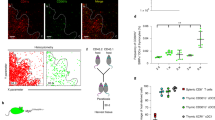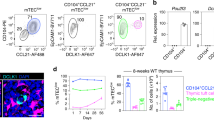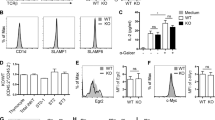Abstract
DENDRITIC cells (DC) derived from bone marrow are critical in the function of the immune system, for they are the primary antigen-presenting cells in the activation of T-lymphocyte response. Their differentiation from precursor cells has not been defined at a molecular level, but recent studies have shown an association between expression of the relB subunit of the NF-κB complex1–5 and the presence of DC in specific regions of normal unstimulated lymphoid tissues4–6. Here we show that relB expression also correlates with differentiation of DC in autoimmune infiltrates in situ, and that a mutation disrupting the relB gene results in mice with impaired antigen-presenting cell function, and a syndrome of excess production of granulocytes and macrophages. Thymic UEA-1+ medullary epithelial cells from normal mice show striking similarities to DC and, interestingly, these cells are also absent in relB mutant mice. Taken together, these results suggest that relB is critical in the coordinated activation of genes necessary for the differentiation of two unrelated but phenotypically similar cells (DC and thymic UEA-1+ medullary epithelial cells) and is therefore a candidate for a gene determining lineage commitment in the immune system.
This is a preview of subscription content, access via your institution
Access options
Subscribe to this journal
Receive 51 print issues and online access
$199.00 per year
only $3.90 per issue
Buy this article
- Purchase on Springer Link
- Instant access to full article PDF
Prices may be subject to local taxes which are calculated during checkout
Similar content being viewed by others
References
Grilli, M., Chiu, J. S. & Lenardo, M. J. Int. Rev. Cytol. 143, 1–62 (1993).
Nolan, G. P. & Baltimore, D. Curr. Opin. Genet. Dev. 2, 211–220 (1992).
Ryseck, R.-P. et al. Molec. cell. Biol. 12, 674–684 (1992).
Lernbecher, T., Müller, U. & Wirth, T. Nature 365, 767–770 (1993).
Lernbecher, T., Kistler, B. & Wirth, T. EMBO J. 13, 4060–4069 (1994).
Carrasco, D., Ryseck, R. P. & Bravo, R. Development 118, 1221–1231 (1993).
Lo, D., Quill, H., Burkly, L., Scott, B., Palmiter, R. D. & Brinster, R. L. Am. J. Pathol. 141, 1237–1246 (1992).
Metlay, J. P., Pure, E. & Steinman, R. M. J. exp. Med. 169, 239–254 (1989).
Sprent, J. & Schaefer, M. Int. Immun. 1, 517–525 (1989).
Levin, D., Constant, S., Pasqualini, T., Flavell, R. & Bottomly, K. J. Immun. 151, 6742–6750 (1993).
Coutelier, J. P., van der Logt, J. T. M., Heessen, F. W. A., Warnier, G. & van Snick, J. J. exp. Med. 165, 64–69 (1987).
Hocart, M. J., MacKenzie, J. S. & Stewart, G. A. J. gen. Virol. 70, 809–818 (1989).
Janeway, C. A. et al. Immun. Rev. 101, 39–80 (1988).
Mosmann, T. R. & Coffman, R. L. A. Rev. Immun. 7, 145–173 (1989).
Knight, S. C. & Stagg, A. J. Curr. Opin. Immun. 5, 374–382 (1993).
Larsen, C. P. et al. J. exp. Med. 172, 1483–1493 (1990).
Farr, A. G. & Anderson, S. K. J. Immun. 134, 2971–2979 (1985).
Surh, C. D. et al. J. exp. Med. 176, 495–505 (1992).
Degermann, S., Surh, C. D., Glimcher, L. H., Sprent, J. & Lo, D. J. Immun. 152, 3254–3263 (1994).
Nelson, A. J., Hosier, S., Brady, W., Linsley, P. S. & Farr, A. G. J. Immun. 151, 2453–2461 (1993).
Mizuochi, T., Kasai, M., Kokuho, T., Kakiuchi, T. & Hirokawa, K. J. exp. Med. 175, 1601–1605 (1992).
Hoffman, M. W., Allison, J. & Miller, J. F. A. P. Proc. natn. Acad. Sci U.S.A. 89, 2536–2530 (1992).
Burkly, L. C., et al. J. Immun. 151, 3954–3960 (1993).
Poirier, B., Lo, D., Reilly, C. R. & Kaye, J. Immunity 1, 385–391 (1994).
Inaba, K. et al. Proc. natn. Acad. Sci. U.S.A. 90, 3038–3042 (1993).
Ip, Y. T. et al. Cell 75, 753–763 (1993).
Scott, B. et al. Immunity 1, 73–82 (1994).
Lo, D. et al. Eur. J. Immun. 23, 1693–1698 (1993).
Arnold, B., Burgert, H.-G., Archibald, A. L. & Kvist, S. Nucleic Acids Res. 12, 9473–9486 (1984).
Author information
Authors and Affiliations
Rights and permissions
About this article
Cite this article
Burkly, L., Hession, C., Ogata, L. et al. Expression of relB is required for the development of thymic medulla and dendritic cells. Nature 373, 531–536 (1995). https://doi.org/10.1038/373531a0
Received:
Accepted:
Issue Date:
DOI: https://doi.org/10.1038/373531a0
This article is cited by
-
Mitochondrial protein C15ORF48 is a stress-independent inducer of autophagy that regulates oxidative stress and autoimmunity
Nature Communications (2024)
-
Embryonic keratin19+ progenitors generate multiple functionally distinct progeny to maintain epithelial diversity in the adult thymus medulla
Nature Communications (2023)
-
Autoantibodies against type I IFNs in humans with alternative NF-κB pathway deficiency
Nature (2023)
-
RelB upregulates PD-L1 and exacerbates prostate cancer immune evasion
Journal of Experimental & Clinical Cancer Research (2022)
-
Changes in expression of nuclear factor kappa B subunits in the ovine thymus during early pregnancy
Scientific Reports (2022)
Comments
By submitting a comment you agree to abide by our Terms and Community Guidelines. If you find something abusive or that does not comply with our terms or guidelines please flag it as inappropriate.



